Home Tags Posts tagged with "Windows 8"
Windows 8
Microsoft officially stopped selling retail copies of both Windows 7 and Windows 8 on October 31.
The date to stop selling the software was set some time ago and should help Microsoft move people on to more recent versions of its operating system.
Separately, statistics suggest people are finally moving away from some very old versions of Windows.
The next version of Windows, called Windows 10, is due to be released in late 2015.
From October 31, consumers could no longer buy copies of the Home Basic, Home Premium and Ultimate versions of Windows 7. Now, Windows 8 is also no longer available. The change affects both copies bought in shops or loaded on PCs and laptops.
The current version of Windows, 8.1, will be the default version offered on PCs.

Microsoft officially stopped selling retail copies of both Windows 7 and Windows 8 on October 31
The change will take time to feed through into the market, as many PC makers have large stocks of older versions of Windows and will continue to sell PCs running the software.
Those keen to get a computer running Windows 7 will be able to “downgrade” from 8.1 to Windows 7 Professional but relatively few PC firms offer this option.
The original version of Windows 8 did not prove popular because it did away with some familiar elements of the desktop version of the operating system.
Windows 7 has been available since late 2009 and is still very popular among users. About 53% of Windows users are on the various editions of Version 7 of Windows. The more recently released Windows 8 has only grabbed a 6% market share and has already been surpassed by 8.1.
Separately, market analysis reveals that the numbers of people using the venerable Windows XP operating system has suddenly seen a sharp decline. Data from Netmarketshare suggests that in October this year its share dropped from almost 24% to just over 17%.
The Start button is returning to Microsoft desktop mode’s taskbar of its Windows 8 operating system, the company has confirmed.
The lack of the facility – which had been in every previous version since Windows 95 – has been one of the most controversial aspects of the software.
However, it will not offer all the functionality previously associated with the feature.
Instead it will bring users to the recently-introduced “Metro” interface.
“We’ve improved the way you navigate to Start with the mouse by changing the Start ‘tip’ to be the familiar Windows logo,” the company said in a blog post.
“The new tip appears anytime you move the mouse to the bottom left corner of the screen, and is always visible on the taskbar when on the desktop.”
On current versions of Windows 8, the start tip would only appear when users hovered their cursor over the lower-left corner of their screen.
In the 8.1 update, the area will be more visible.
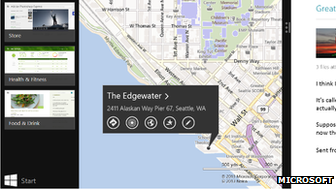
The Start button is returning to Microsoft desktop mode’s taskbar of its Windows 8 operating system
A left-click on the tip will bring up a tile-based Start Screen – formerly known as the Metro interface – designed for touch-screen users.
A right-click will display a small menu of other options such as Event Viewer, Device Manager and Disk Management.
Another change will allow users to boot their computers directly into desktop mode, meaning they can avoid ever using the Start Screen if they wish.
Many users had complained that ditching the traditional Start Menu and introducing the Start Screen had made the system less straight-forward to use, meaning businesses which adopted it would need to retrain staff.
Microsoft had been stung by claims that the expected reintroduction of a Start button would mark a major U-turn.
An article in the Financial Times described the move as one of the “most prominent admissions of failure for a new mass-market consumer product since Coca-Cola’s New Coke fiasco nearly 30 years ago” – making reference to the soft drinks company’s decision to ditch a new recipe after overwhelming customer dissatisfaction.
Microsoft later issued a statement saying it was “unfortunate” the FT did not represent the “good response to date on Windows 8.”
A preview download of Windows 8.1 will be released to the public in June, and a final version before the end of the year. Both will be free of charge to existing users.
Other changes that will appear to users running the update include:
- Added customization options, with more choice over colours and backgrounds on the Start Screen.
- An improved search function that covers web content as well as apps, files and settings on the PC.
- A new version of the firm’s web browser – Internet Explorer 11 – which Microsoft said would offer improved tools for developers.
Microsoft has started shipping its first Surface tablet computers ahead of their official launch on October 26th.
According to Microsoft site, it has sold out of pre-orders for the 32GB version of the device, which runs the RT version of Windows 8.
It marks Microsoft’s entry into the PC hardware market, posing competition to other computer manufacturers.
Early reviews of the device have been mixed, praising the hardware but criticizing a lack of software.
Surface with Windows RT – to give the device its full name – runs on a chip made by Nvidia, based on the designs of British company Arm Holdings.
It is designed to be cheaper and offer longer battery life than products using x86 chips that run the full Windows 8 system.
The caveat is that Windows RT devices can only install third-party software from Microsoft’s own Windows Store.
Although they do offer a traditional desktop mode, the only programs that can be run under it are Microsoft’s Office 2013 suite and a limited number of the firm’s other products.
Until more third-party apps are developed for the touch-interface mode, users face a significantly smaller selection of software than they would on traditional Windows devices and tablets powered by Apple’s iOS or Google’s Android operating systems.
Microsoft intends to launch an Intel-based version of the Surface offering the full Windows 8 system in January.
But it does appear there is demand for the Windows RT.
Although Microsoft has not disclosed sales figures, it said that pre-orders of the 32GB version of the tablet – which costs $600 – had “temporarily sold out” in the US, Canada, France, Germany and the UK within a day of going on sale.
An $860 64GB version bundled with a Touch Cover keyboard remains on offer.
Reviewers have given a mixed reaction to the machine.
“This is one of the most of exciting pieces of hardware I’ve ever used,” enthused Wired’s Matthew Honan.
“It is extremely well-designed; meticulous even.”
He praised the ability to type quickly on the machine’s Type Cover – the $150 add-on that doubles as a keyboard and screen protector, offering an alternative to on-screen typing.
However, he criticized its cameras as “junk” and highlighted the lack of software.
“I missed apps like Dropbox and 1Password and Rdio,” he wrote.

Microsoft has started shipping its first Surface tablet computers ahead of their official launch on October 26th
The Wall Street Journal’s Walt Mossberg also commended the machine’s physical aspects.
“It’s a unique tablet, made of a type of magnesium with a feeling of quality and care,” he wrote.
However, he criticized its battery life, and highlighted problems with the third-party apps that were available.
“Evernote took a long time to synchronize my account, and the Kindle app had to stop every few pages to fetch the next section.”
The Verge’s Joshua Topolsky also complained some games felt “sluggish” on the machine, however he said Microsoft’s own Internet Explorer browser and Xbox Music apps showed “how playful and fresh this version of Windows can be”.
But Techcrunch’s Matt Burns decided that he could not recommend consumers buy the tablet in its current state, complaining that its 10.6 in (26.9 cm) size made it unwieldy.
“With its awkward size and incomplete operating system, the Surface fails to excel at anything particular in the way other tablets have,” he wrote.
However, he said it could offer an alternative to existing low-end laptops if Microsoft could attract more software developers.
“If properly nurtured, Windows RT and the Surface RT could be something worthwhile,” he said.
Microsoft’s chief executive Steve Ballmer may unveil more apps when he hosts an event to show off the tablets alongside the various versions of Windows 8 on Thursday in New York.
The devices and software will go on sale the next day.
Microsoft will face competition from Dell, Asus, Lenovo and Samsung, who have also unveiled Windows RT devices over recent weeks.
Apple is also attempting to woo consumers with its new iPad mini and revised fourth generation full-sized iPad, and Amazon has just launched its Android-powered Kindle Fire tablet family in the UK.
Google is also expected to unveil further Android tablets built by other manufacturers at an event on Monday, adding to the Nexus 7 it has already launched alongside Asus.
“It is really hard for consumers as the portfolio of products will be huge this Christmas season,” said Francisco Jeronimo, mobile device researcher at consultants IDC.
“Microsoft is trying to promote its entire eco-system – including its own Office software and the fact it can offer integration between Windows computers, Windows Phone handsets and the Xbox games console – to gain an edge.
“But it faces a huge problem as its rivals are offering cheaper-priced devices.”
Other analysts have noted, however, that Microsoft would risk angering other Windows 8 device makers were it to copy Amazon’s strategy of selling its tablets at break-even prices.
What is launching when:
24 Oct: Samsung (New York)
Will give details of US launch of Galaxy Note 2
25 Oct: Microsoft (New York)
Launch event for Windows 8 which goes on sale, alongside Surface tablets, the next day
29 Oct: Google (New York)
Android-themed event, may include new Nexus devices
29 Oct: Microsoft (San Francisco)
Launch of Windows Phone 8 operating system
30 Oct: Arm (London)
Mobile device chip designer and “partners” announce news
Gabe Newell, Valve Software’s boss, has said that OS Windows 8 will be a “catastrophe” for PC game makers.
Speaking at the Casual Connect game conference in Seattle, Gabe Newell said the next version of Windows could mean big changes to the PC market.
Many took his comment as a criticism of the changed user interface in Windows 8 as well as its built-in Windows Store.
The Windows Store could dent the success of Valve’s own online market, Steam, through which players buy games.
Gabe Newell, who worked for Microsoft for 13 years on Windows, said his company had embraced the open-source software Linux as a “hedging strategy” designed to offset some of the damage Windows 8 was likely to do.
“We want to make it as easy as possible for the 2,500 games on Steam to run on Linux as well,” said Gabe Newell.
“Windows 8 is a catastrophe for everyone in the PC space.”

Gabe Newell, Valve Software's boss, has said that OS Windows 8 will be a "catastrophe" for PC game makers
The arrival of Windows 8 would be likely to drive some PC makers and others out of the business because it put so much pressure on their sales margins, Gabe Newell added.
He said the success of Valve, known for its Half Life, Left4Dead and Portal titles, had been down to the open nature of the PC.
“We’ve been a free rider, and we’ve been able to benefit from everything that went into PCs and the internet,” he told the conference.
“And we have to continue to figure out how there will be open platforms.”
However, he added, the openness that helped Valve as well as firms such as Google and Zynga could disappear with Windows 8.
“There’s a strong temptation to close the platform because they look at what they can accomplish when they limit the competitors’ access to the platform, and they say, <<That’s really exciting>>.”
This is seen by commentators to be a reference to the inclusion of a Windows Store in the Microsoft operating system.
This is a shop through which users will be able to buy apps for their Windows 8 device.
On some versions of Windows 8, it will be the only way to get downloadable software such as games.
Microsoft takes a cut, up to 30%, of every sale made through this store.
This could be a significant threat to the massively successful Steam online game store that Valve runs and which gives it a commission on every title sold through the online market.
A Windows Store closed to everyone but Microsoft might reduce the range of games available for sale through Steam.
Windows 8’s links with Microsoft’s Xbox Live online game service could also dent the appeal of Steam for many people.
Gabe Newell said Valve was preparing for the future in other ways. In particular, he said, it was trying to make tools and services that players could use to make games and gaming more fun for everyone.
“We think the future is very different [from] successes we’ve had in the past,” he said.
“When you are playing a game, you are trying to think about creating value for other players, so the line between content player and creator is really fuzzy.”
One harbinger of this future was perhaps found, he said, in the success of one Team Fortress player in Kansas who was earning $150,000 a year making virtual hats.
“This isn’t about video games,” he said.
“It’s about thinking about goods and services in a digital world.”
Windows 8 will be released on October 26, Microsoft has revealed.
The declaration was made at the firm’s annual sales meeting and was published on its blog shortly after.
The firm has described the update as the most important redesign of its interface in more than a decade.
The announcement was made a day before the firm releases its fourth quarter earnings report. Analysts say it may post its first ever loss after writing down the value of a troubled takeover.
Microsoft paid $6.3 billion for the online advertising service Aquantive in 2007 but has said the service did not perform as expected. As a result its earnings will be offset by a $6.2 billion charge.
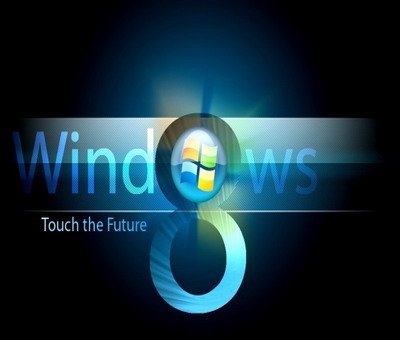
Windows 8 will be released on October 26
Microsoft’s future efforts are now focused on its upcoming system software release.
Windows 8 includes a touch-controlled interface dubbed Metro as well as a more traditional desktop.
It will be released in a version that runs on ARM-based chips for the first time, as well as versions for x86-based ones designed by Intel and AMD.
Some consumers will have delayed buying new computers ahead of the release, depressing Microsoft’s sales in the meantime.
However, many companies have continued with their roll-out of Windows 7 as it typically takes big firms’ IT departments months or years after a major system update to approve its installation on workers’ computers.
Part of Microsoft’s goal in the initial months will be to eat into sales of rivals’ tablet computers.
Apple’s iPad and Amazon’s Kindle Fire have dominated the sector while Google’s new Nexus 7 has also attracted positive reviews.
Microsoft hopes to make the most of the fact that it can offer a single system that can power both desktop PCs and mobile devices – allowing progams to work on both – as opposed to Apple’s decision to offer different Mac OS X and iPad iOS systems.
Microsoft has also taken the out-of-character step of announcing its own hardware – the Surface family of tablets – to compete with other companies’ products on the Windows 8 platform to maximize its chances.
But since announcing the news chief executive Steve Ballmer has sought to reassure his company’s hardware partners, describing Surface as “a design point” that would have a place within a “broad Windows ecosystem”.
Whatever the case, investors appear hopeful despite the problems with Aquantive.
“Microsoft’s stock is up 17% since the start of the year in part because of anticipation for Windows 8 and Surface,” said Colin Gillis, senior technology analyst at BGC Partners.
“We’re also still seeing nearly one million PCs sold worldwide a day so that’s a sizeable marketplace for them.”
Microsoft has unveiled Surface, its own-brand family of tablets, which will be powered by its upcoming Windows 8 system and contains a choice of an Intel or ARM-based processor.
It allows Microsoft to challenge Apple’s bestselling iPad with a device that can run standard applications such as its own Office programs and Photoshop.
But it puts Microsoft in competition with other manufacturers planning to release tablets designed for Windows 8.
The company’s chief executive, Steve Ballmer, said he had wanted to give the software “its own companion hardware”.
The devices have 10.6 inch (26.9 cm) displays, built-in kickstands and are housed in magnesium cases – which the company described as the first of their kind.
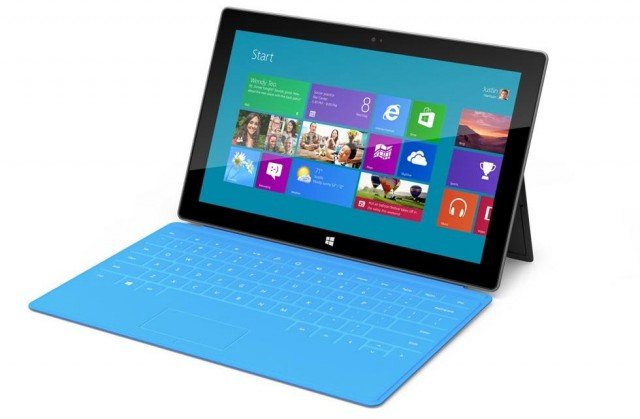
Microsoft has unveiled Surface, its own-brand family of tablets, which will be powered by its upcoming Windows 8 system and contains a choice of an Intel or ARM-based processor
The ARM-based tablets are 9.3 mm (0.4 inches) thick – slightly less than the iPad – and run the Windows RT version of the new system. The Verge reported that the chipset will be built by Nvidia.
The versions using Intel’s x86 technology run Windows 8 Pro and are 13.5 mm (0.5 inches) thick.
The specifications mean the Surface tablets have bigger screens than the iPad but are heavier.
A variety of accompanying covers can be attached using built-in magnets. They double as keyboards with trackpads. One version is flat while the other offers keys that can be depressed.
The devices are also designed to work with a pen accessory using what the firm dubbed “digital ink”. When the stylus is held close to the screen of the tablet it ignores touch-input from the users’ hands and “samples” the ink at 600 dpi (dots per inch).
The ARM-based version will be available with either 32 GB (gigabytes) or 64 GB of storage. Microsoft said they would be priced at a similar rate to other tablets using the same type of processor built by other firms.
It added that the Intel-based versions would be offered with either 64 GB or 128 GB of storage and would have price tags comparable to ultrabook laptops.
The firm’s designs have already proved popular with smartphone makers, but Microsoft’s support for its technology in Windows 8 offers it the potential to expand into a market dominated until now by Intel and AMD.
“This represents a significant milestone in Microsoft’s journey to expand the support of the Windows operating system and embrace the ARM architecture,” said Lance Howarth, the firm’s vice president of marketing.
“With the Surface for Windows RT announcement we are delighted to see yet another example of this partnership in action which follows on from various Windows RT devices demonstrated at Taiwan’s Computex show recently.”
Microsoft launches the most complete preview yet of its upcoming Windows 8 operating system.
Microsoft said that tens of thousands of improvements have been made to what it calls the most important redesign of its interface since Windows 95.
Consumers can now download the release preview of Windows 8, a system which Microsoft says is its most tested operating system ever.
It is expected to go on sale in the autumn, three years after Windows 7.

Microsoft launches the most complete preview yet of its upcoming Windows 8 operating system
The new operating system is designed to bring Windows into the touchscreen, smartphone era.
It adopts the Metro interface of the company’s mobile operating system, Windows Phone 7.
Windows, which still dominates the desktop PC software market, has been much slower to make an impact on mobile phones and tablet computers.
The release preview has features not available in the last version, the consumer preview, launched in February.
There will be new apps for the Bing search engine, news and sports, and improvements to the mail and photo applications unveiled previously.
The latest version of Microsoft’s browser Internet Explorer 10, optimized for touchscreen, is also included for the first time. Users are promised greater personalisation of the start screen, and more control over privacy.
Internet Explorer 10 will be the first browser with “do not track” turned on by default, meaning users can easily decide not to accept cookies.
Microsoft said manufacturers and developers are at work on new devices and apps designed to make the most of Windows 8’s features.
[youtube NJxQezX9L8U]
Microsoft has announced that its next operating system Windows 8 will come in just three different flavors.
For those with Intel-compatible machines, the OS will be available in two versions – Windows 8 and Windows 8 Pro.
And for those with devices, largely tablets, powered by ARM-designed chips there will be a Windows RT version.
Microsoft wants to simplify how it markets Windows 8, which is expected to launch in autumn 2012.
The complex flavors of past Windows – from basic to home, premium to ultimate – have become something of a joke among tech experts.
Microsoft has called Windows 8 the most significant redesign of the Windows interface since its groundbreaking Windows 95 OS.
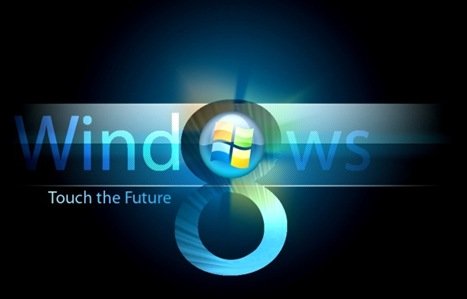
Windows 8 and Windows 8 Pro will be available for Intel-compatible machines and Windows RT for tablets
The ARM version of the OS is the newest edition and reflects Microsoft’s desire to unify the engine known for running desktop computers with that for tablets and smartphones. Windows RT will sit alongside Apple’s iOS and Google’s Android operating systems.
It announced the new flavors on its Windows blog.
Many of those reacting to the announcement were unimpressed by the name for its ARM version.
“You guys are doing a phenomenal job with Windows Phone, Windows 8, etc, which makes the naming of <<Windows RT>> all the more maddening. You’re trying to simplify the rest of the <<Windows Live>> properties, which I applaud, but then you go with Windows RT? Does. not. compute,” said Michael Jenke, summing up the views of many responses to the blog.
In an earlier 8,600-plus word blog post Windows president Steven Sinofsky detailed the “energizing and daunting” challenges in developing Windows on ARM.
A preview version of Windows 8 launched late last year and more than 100,000 changes had been made since the developer version went public.
For the first time since its inception, the trademark Windows “Start” button will no longer appear – instead being replaced by a sliding panel-based menu.
In a footnote in its blog, Microsoft said that there would be an adapted version of Windows 8 Pro for businesses.
Microsoft has announced is offering the public a free trial of its upcoming Windows 8 operating system from today.
Windows 8 will run on tablets as well as desktops and laptops – and is a sea-change for Windows that is seen as a make-or-break opportunity for Microsoft.
Tablets and cloud computing have made Bill Gates’ vision of “a computer on every desk and in every home” seem quaint – Windows 8 aims to adapt the iconic operating system for life in the mobile world of tablets.
Windows 8 will come in two variations, one that works on desktops and laptops, and a new version for the ARM microprocessors in tablets, smartphones and other portable devices.
There is no set release date, but it’s widely expected to be available in autumn – offering Microsoft Office free on tablets, which could be a “killer app” that puts Windows 8 machines ahead of Apple devices.
In both versions, Windows 8 features a completely new interface, borrowed from what Microsoft calls the “Metro” style of the current Windows Phone software.
Download Windows 8 free trial version from here.
Early reactions have been highly positive.
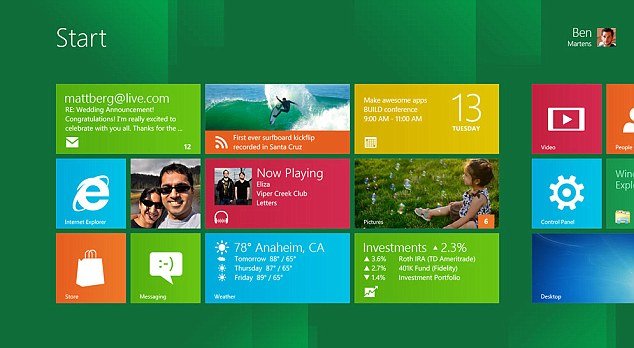
Windows 8 will come in two variations, one that works on desktops and laptops, and a new version for the ARM microprocessors in tablets, smartphones and other portable devices
Microsoft is also opening an Internet “Windows Store” where users can download applications for the operating system.
Applications are free for those testing out the beta version, but would include both free and paid versions after the operating system is released.
The test version was downloaded by people from more than 70 countries as Microsoft gave its presentation about Windows 8, but the company didn’t immediately disclose the number of downloads.
Windows 8 Features
Touchscreen compatible – the new OS will work with tablets and portable devices. There will also be a version for PC’s.
Fewer windows – instead of “stacks” of windows, as in previous versions, the OS is built around clean ’tiles’ that deliver information to the home screen.
Free versions of Word, Excel and Powerpoint – Windows 8 will offer Office free to tablet users.
Business-friendly tablets – Windows 8 will work smoothly with Microsoft Exchange email systems, so could be highly popular with business.
Apps shared with phones – apps in Windows 8 will be built to work smoothly with phones (such as Nokia’s) running Microsoft’s Windows Phone OS.
Easier passwords – users will be able to unlock PCs with a PIN, or by circling details in a picture.
No Start button – instead, users will access a menu from a “hot corner” in the bottom left of the screen.









